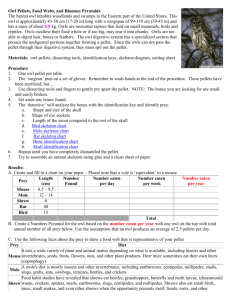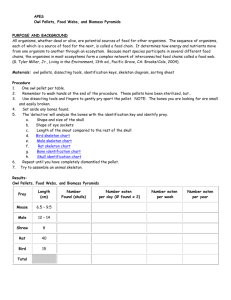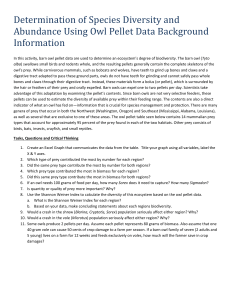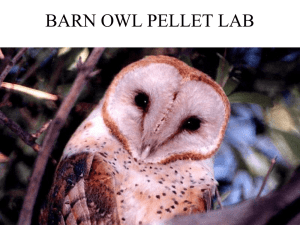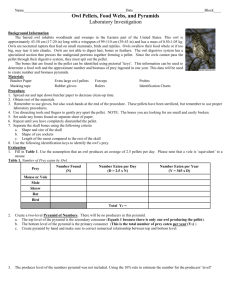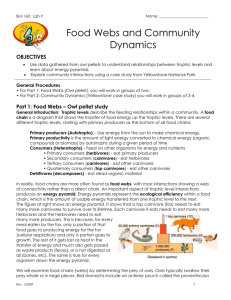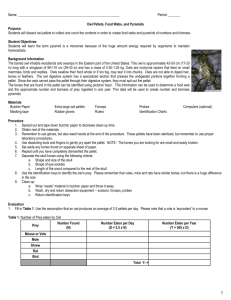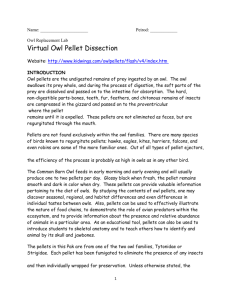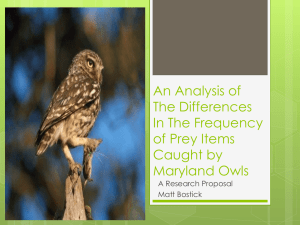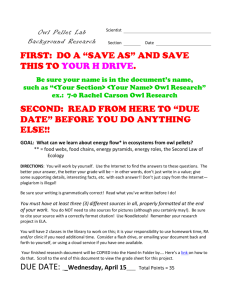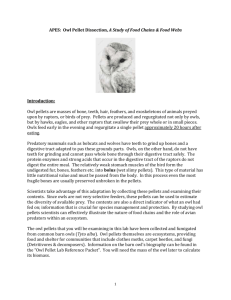Owl Pellets, Food Webs, and Biomass Pyramids
advertisement
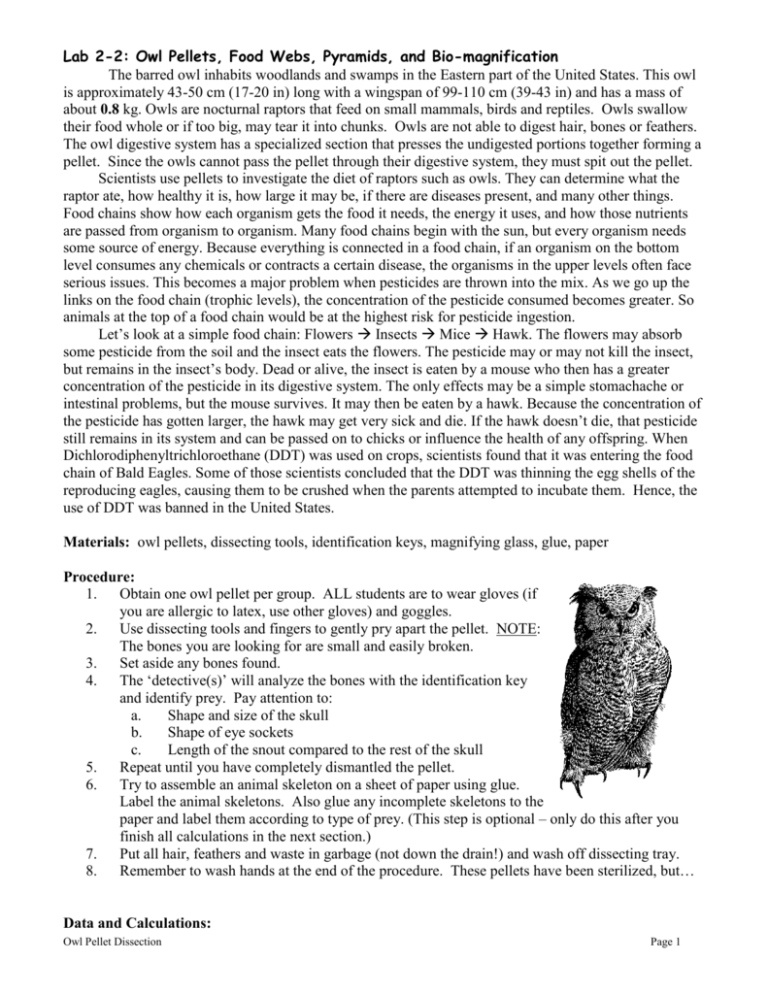
Lab 2-2: Owl Pellets, Food Webs, Pyramids, and Bio-magnification The barred owl inhabits woodlands and swamps in the Eastern part of the United States. This owl is approximately 43-50 cm (17-20 in) long with a wingspan of 99-110 cm (39-43 in) and has a mass of about 0.8 kg. Owls are nocturnal raptors that feed on small mammals, birds and reptiles. Owls swallow their food whole or if too big, may tear it into chunks. Owls are not able to digest hair, bones or feathers. The owl digestive system has a specialized section that presses the undigested portions together forming a pellet. Since the owls cannot pass the pellet through their digestive system, they must spit out the pellet. Scientists use pellets to investigate the diet of raptors such as owls. They can determine what the raptor ate, how healthy it is, how large it may be, if there are diseases present, and many other things. Food chains show how each organism gets the food it needs, the energy it uses, and how those nutrients are passed from organism to organism. Many food chains begin with the sun, but every organism needs some source of energy. Because everything is connected in a food chain, if an organism on the bottom level consumes any chemicals or contracts a certain disease, the organisms in the upper levels often face serious issues. This becomes a major problem when pesticides are thrown into the mix. As we go up the links on the food chain (trophic levels), the concentration of the pesticide consumed becomes greater. So animals at the top of a food chain would be at the highest risk for pesticide ingestion. Let’s look at a simple food chain: Flowers Insects Mice Hawk. The flowers may absorb some pesticide from the soil and the insect eats the flowers. The pesticide may or may not kill the insect, but remains in the insect’s body. Dead or alive, the insect is eaten by a mouse who then has a greater concentration of the pesticide in its digestive system. The only effects may be a simple stomachache or intestinal problems, but the mouse survives. It may then be eaten by a hawk. Because the concentration of the pesticide has gotten larger, the hawk may get very sick and die. If the hawk doesn’t die, that pesticide still remains in its system and can be passed on to chicks or influence the health of any offspring. When Dichlorodiphenyltrichloroethane (DDT) was used on crops, scientists found that it was entering the food chain of Bald Eagles. Some of those scientists concluded that the DDT was thinning the egg shells of the reproducing eagles, causing them to be crushed when the parents attempted to incubate them. Hence, the use of DDT was banned in the United States. Materials: owl pellets, dissecting tools, identification keys, magnifying glass, glue, paper Procedure: 1. Obtain one owl pellet per group. ALL students are to wear gloves (if you are allergic to latex, use other gloves) and goggles. 2. Use dissecting tools and fingers to gently pry apart the pellet. NOTE: The bones you are looking for are small and easily broken. 3. Set aside any bones found. 4. The ‘detective(s)’ will analyze the bones with the identification key and identify prey. Pay attention to: a. Shape and size of the skull b. Shape of eye sockets c. Length of the snout compared to the rest of the skull 5. Repeat until you have completely dismantled the pellet. 6. Try to assemble an animal skeleton on a sheet of paper using glue. Label the animal skeletons. Also glue any incomplete skeletons to the paper and label them according to type of prey. (This step is optional – only do this after you finish all calculations in the next section.) 7. Put all hair, feathers and waste in garbage (not down the drain!) and wash off dissecting tray. 8. Remember to wash hands at the end of the procedure. These pellets have been sterilized, but… Data and Calculations: Owl Pellet Dissection Page 1 A. Complete Chart #1 below – Please note that a vole is ‘equivalent’ to a mouse Chart #1. Number of prey eaten by a barred owl per time interval. A B C D Length Number Number eaten Number eaten Prey (cm) Found in per day per week 1 pellet (2.5 pellets/day) (7 days/wk) Class data B x 2.5 = C Cx7=D 6.5 – 9.5 Mouse 12 – 14 Mole 8 Shrew 40 Rat 15 Bird Total E Number eaten per year (52 weeks/yr) D x 52 = E B. Create and label a Pyramid of Numbers for the owl based on the number eaten per year with one owl on the top with total annual number of all prey below. *Use the assumption that an owl produces an average of 2.5 pellets per day. Draw your pyramid of numbers on separate paper. C. Use the following facts from Chart #2 about the prey to draw a complete food web that is representative of the pellet your group dissected. Draw your food web on separate paper. Chart #2. The diets of various barred owl prey. Prey Diet It eats a wide variety of plant and animal matter depending on what is available, including Mouse insects and other invertebrates, seeds, fruits, flowers, nuts, and other plant products. Deer mice sometimes eat their own feces (coprophagy). A mole's diet is mostly insects and other invertebrates, including earthworms, centipedes, Mole millipedes, snails, slugs, grubs, ants, sowbugs, termites, beetles, and crickets Food habit studies have revealed that shrews eat beetles, grasshoppers, butterfly and moth larvae, ichneumonid wasps, crickets, spiders, snails, earthworms, slugs, centipedes, and Shrew millipedes. Shrews also eat small birds, mice, small snakes, and even other shrews when the opportunity presents itself. Seeds, roots, and other vegetable matter are also eaten by some species of shrews. The rat's diet typically includes seeds, nuts, grains, vegetables, fruits, meats and invertebrates. They consume about one-third of their weight in food every 24 hours. Because of their Rat inability to vomit, rats are very hesitant to try new foods that may be poisonous. They will take a small nibble and wait to see if they feel sick and, if so, will avoid that food in the future. Birds are usually insectivores (eat insects) and frugivores (eat fruit) insects. They also Bird sometimes eat terrestrial non-insect arthropods, seeds, grains, and nuts. Owl Pellet Dissection Page 2 D. Complete Chart #3 below. Chart #3. Calculations for the biomass eaten by barred owl prey. F G H I J K Mass of Number per Mass of Amount of food that Biomass eaten Mass Prey in Prey year Prey in 1 kg of this prey by prey in one year each (g) one year one year (g) eats in one year (kg) (kg) Copy E from Given 1000g = 1 FxG=H Given below IxJ=K Chart #1 below kg 20 45.6 kg Mouse 55 365 kg Mole 5 1168 kg Shrew 240 12.8 kg Rat 20 127 kg Bird E. Use your data to create a Biomass Pyramid. For the top carnivore level you need to see the opening paragraph to find the mass of Barred Owl. For the herbivore level use the assumption that an owl produces an average of 2.5 pellets per day (which you already accounted for in your pyramid of numbers) and the total Mass of prey (kg). For the producer level, make the same assumption and then use the total of the Biomass eaten by the prey. Total mass of all prey consumed by owl per year (Chart #1) = ___________ Total mass of all producers consumed by prey per year (Chart #3) = __________ Draw your biomass pyramid on separate paper. Discussion: Analysis Questions: Answer the following questions in complete sentences, using data from the lab when necessary. 1. Explain why the shape of your Pyramid of Numbers is triangular (rather than rectangular). 2. What is the barred owl’s niche? 3. Other types of birds form pellets. What would you expect to find in the pellet of a seagull? 4. Owls, hawks, and eagles are types of raptors, animals that have hooked beaks and sharp claws, and are therefore adapted for seizing prey animals. Hawks and eagles differ from owls in that they eat their prey animals by tearing them into small pieces, picking out the flesh and avoiding most of the fur and bones. They also have strong stomachs that can digest most of the bone material that they might eat. The relatively small amount of indigestible bone and fur that remain will be compacted by their stomach muscles into a pellet similar to the owl's. Do you think an eagle pellet would be as useful for dissecting as an owl's? Why or why not? 5. What other facts could be determined from examining pellets? 6. How would pesticide use come into play for the raptor food chain? 7. (Honor credit): What is a major source of error in this lab, specifically in the calculations? Why does this error exist? 8. (Extra credit): Why do you think there are no organisms that regularly eat owls? In other words why is the owl a top consumer? Use your data/ diagrams to support your answer. Owl Pellet Dissection Page 3
